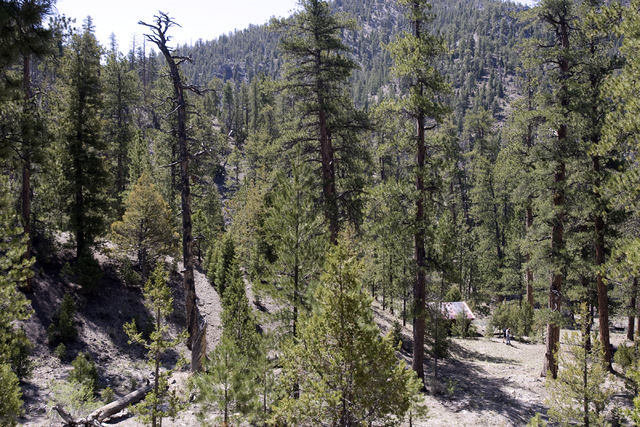Conservationists sound alarm over Air Force plan to expand test range into refuge

The Hidden Forest Cabin would be hidden from public view and Alamo Road all but forgotten under an Air Force proposal to expand its massive test range north of Las Vegas.
Outdoor advocates are sounding the alarm about the Defense Department’s plan to add another 301,507 acres to the Nevada Test and Training Range, which already covers more than 2.9 million acres in Clark, Lincoln and Nye counties.
Roughly 227,000 acres of the proposed expansion could restrict public access to several popular spots in the remote heart of Desert National Wildlife Refuge, including most of the unpaved Alamo Road along the western slope of the Sheep Mountains and the hiking trail to Hidden Forest Cabin, a century-old log structure that may have harbored Prohibition-era bootleggers.
“I’m kind of astounded,” said John Hiatt, an avid hiker and longtime local conservationist. “This is some of the most pristine land in Southern Nevada in terms of human impact. This would completely change that area forever.”
The Air Force is in the early stages of studying the potential environmental impacts of the range expansion.
The proposed action also would renew — perhaps indefinitely — the military’s use of the existing test range under a land withdrawal currently set to expire in 2021.
Air Force officials will hold five meetings next month — Oct. 12 in Beatty, Oct. 13 in Tonopah, Oct. 18 in Caliente, Oct. 19 in Alamo and Oct. 20 in North Las Vegas — to field public comments on the various alternatives.
The Bureau of Land Management, the U.S. Fish and Wildlife Service, the Department of Energy and the Nevada Department of Wildlife are cooperating agencies in the environmental study. But cooperation should not be confused with approval, said Christy Smith, the Fish and Wildlife Service’s project leader for the Desert National Wildlife Refuge Complex.
‘We fully support the status quo, and we fully support the U.S. Air Force,” Smith said. “We would have concerns about any proposal that would restrict public access” to additional portions of the refuge.
At 1.6 million acres, Desert is the nation’s largest wildlife refuge outside of Alaska. President Franklin D. Roosevelt established it in 1936 to protect the desert bighorn sheep and its habitat, but a large portion of the refuge has doubled as a bombing range and military training ground since 1940.
Today the entire western half of the refuge — some 846,000 acres — is under military control and off-limits to the public. The land in question includes a portion of the Nevada Test and Training Range — one of two military training areas used by the U.S. Air Force Warfare Center at Nellis Air Force Base — and all of Creech Air Force Base north of Indian Springs, where operators train and fly drone missions around the globe.
Infamous and ultra-secret Area 51 is just a few miles from the refuge’s northern boundary.
Smith said military and wildlife personnel have done an effective job over the years of jointly managing their shared portion of the refuge, though she acknowledged that “because of the secret nature of the Air Force operation, our time out there is very limited.”
As for the proposed range expansion, Smith said the idea is still in its infancy, and she doesn’t yet know the specifics of the Air Force’s plans. “There is nothing that solid yet,” she said. “There have been no decisions made yet.”
Smith expects more details to emerge at the meetings in October. “Anyone who cares should attend these public meetings and listen,” she said.
In a news release about the proposed land withdrawal, Nellis officials said the additional acreage would be used for Red Flag air combat exercises, new test missions for the F-35 joint strike fighter and “increased irregular warfare training activities.”
“The modernization is required to meet a rapidly changing battlespace which has outpaced the existing range capabilities and capacity, in turn limiting realistic and relevant testing, tactics development and training,” base officials said in the release.
But Hiatt wonders how much land is enough for the military, which has already cordoned off millions of acres of desert across Nevada, California and Arizona yet continues to push for more.
“It’s death by accretion,” he said.
Contact Henry Brean at hbrean@reviewjournal.com or 702-383-0350. Follow @RefriedBrean on Twitter.